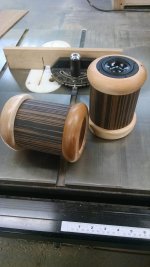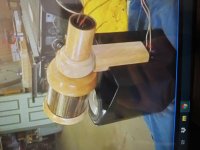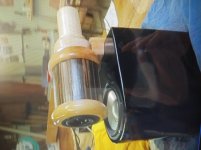I was thinking of undertaking a new project with the goal to produce a no-compromise single mono Bluetooth speaker to play audiobooks and podcasts. I want something that does a great job of naturally reproducing the male and female speaking voice with everything else not being important.
I'm thinking of doing some type of omni-directional or di-pole design where the speaker can be placed flexibly in a room and not have the listening sweet spot limited to a small location.
Anyone have ideas or suggestions to get me rolling on this idea?
I'm thinking of doing some type of omni-directional or di-pole design where the speaker can be placed flexibly in a room and not have the listening sweet spot limited to a small location.
Anyone have ideas or suggestions to get me rolling on this idea?
An overkill for you may be a constant beamwidth transducer (CBT) array that would meet your wide room sized sweet spot desire. The technology comes from Don Keele Jr. the famous long time loudspeaker pioneer in the field.
My Modified CBT24 arrays were derived from Don's work and have exceptional in-room performance. See my journey at:
My New Line Array--It's a Modified CBT24
Jim
My Modified CBT24 arrays were derived from Don's work and have exceptional in-room performance. See my journey at:
My New Line Array--It's a Modified CBT24
Jim
Last edited:
Some ideas
Resistance / aperiodic enclosure. A very simple and small box with an acoustic resistance vent. Something like this: US2065751A - Acoustic resistance device
- Google Patents
You could use Dynaudio / ScanSpeak Variovent or construct a similar device by yourself.
Driver:
QTS < 0.45
SPL ≈ 90 dB
Single cone design.
I don't know what kind of amplifier you would use, but in case you chose low voltage and class AB, then low impedance ( 4 Ω or less ) and high efficiency would be desirable properties for the driver.
With an aperiodic speaker enclosure you could also use current-drive with an amplifier like this: Current Drive
Or if you wish to make a class D amplifier, then perhaps something like this: US7924091B2 - Class-D transconductance amplifier
- Google Patents
You want the speaker omnidirectional, so make the driver shout down and place a conical mirror below to spread sound. I think that would be the natural way to prevent the driver collecting dust.
More about omnidirectional speakers: Omnidirectional speakers
Resistance / aperiodic enclosure. A very simple and small box with an acoustic resistance vent. Something like this: US2065751A - Acoustic resistance device
- Google Patents
You could use Dynaudio / ScanSpeak Variovent or construct a similar device by yourself.
Driver:
QTS < 0.45
SPL ≈ 90 dB
Single cone design.
I don't know what kind of amplifier you would use, but in case you chose low voltage and class AB, then low impedance ( 4 Ω or less ) and high efficiency would be desirable properties for the driver.
With an aperiodic speaker enclosure you could also use current-drive with an amplifier like this: Current Drive
Or if you wish to make a class D amplifier, then perhaps something like this: US7924091B2 - Class-D transconductance amplifier
- Google Patents
You want the speaker omnidirectional, so make the driver shout down and place a conical mirror below to spread sound. I think that would be the natural way to prevent the driver collecting dust.
More about omnidirectional speakers: Omnidirectional speakers
Fane 12-250TC would be my choice.
Having heard that exact driver, I'd veto that. Rough in the kHz range, and wants a really big box.
To the OP, the SB65 is pretty good. Maybe use it up-firing with a small conical deflector to get it towards omni.
Chris
I have a pair in a small box here that sound very good.
I wouldn't have recommended it otherwise.
I wouldn't have recommended it otherwise.
These are the best speakers i have heard for voice. Drivers come in pairs so a bi-pole/omni-pole could be devised. I would look to a castle-stle arrangement of drivers.
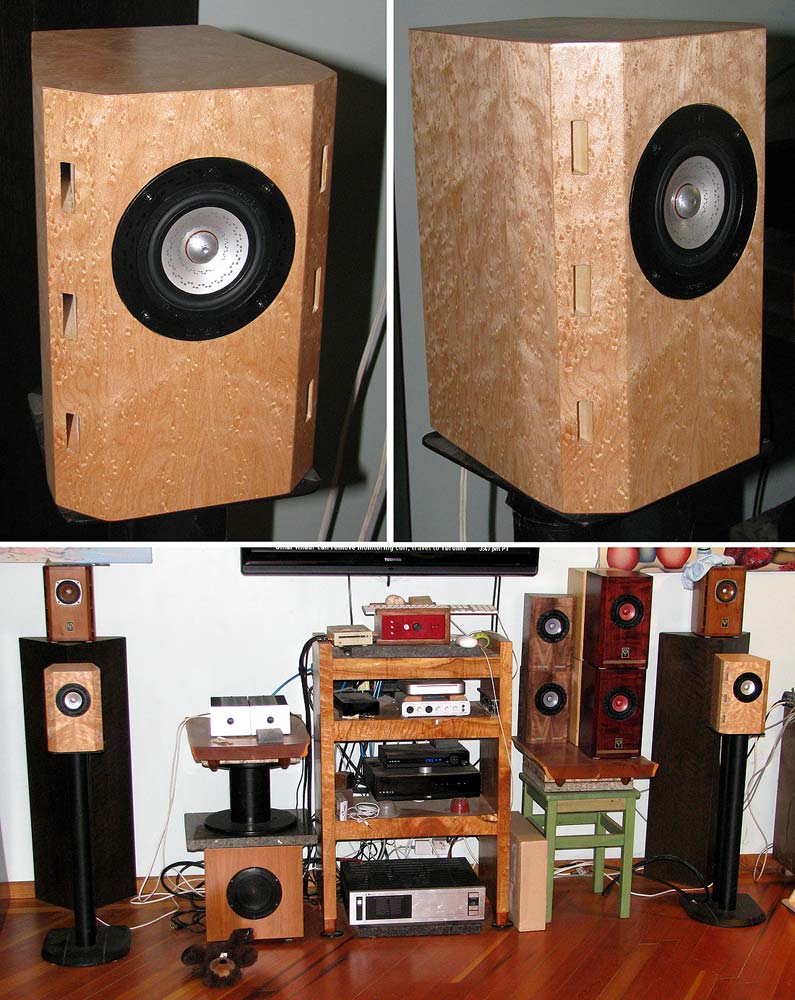
1st thot woud be the mMar-Ken6pT box, same shape, 2x as big) one on the front, one on the top of this box drivers wired in series):
http://www.planet10-hifi.com/planset/MarKen-A6-extents-030218.pdf
dave

1st thot woud be the mMar-Ken6pT box, same shape, 2x as big) one on the front, one on the top of this box drivers wired in series):
http://www.planet10-hifi.com/planset/MarKen-A6-extents-030218.pdf
dave
I have those in the rectangular version of th ebox i posted. It is good.
I did not get to compare to a stock Alpair 5.2/3, but once EnABLed i figure the Faital Pro would be in the same league as the Alpair or FF85wKeN.
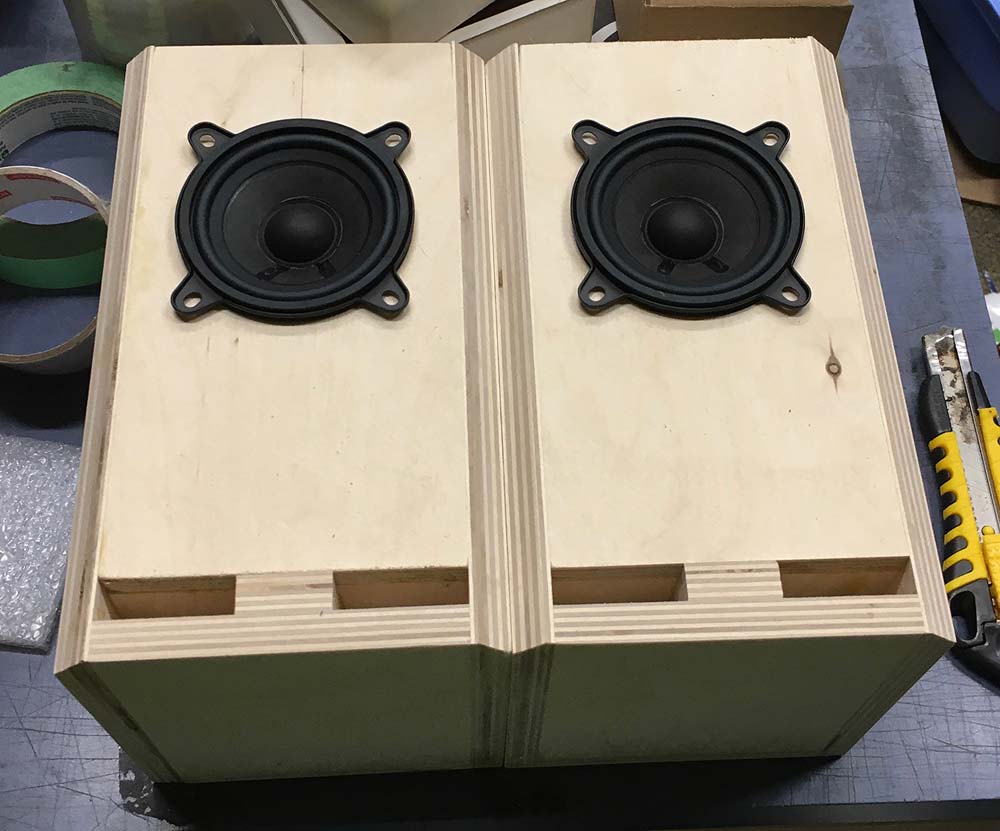
dave
I did not get to compare to a stock Alpair 5.2/3, but once EnABLed i figure the Faital Pro would be in the same league as the Alpair or FF85wKeN.

dave
Completely natural vocal reproduction should include (but not enhance or distort) sibilance, which typically occurs in the 5k to 10k range, but can go higher. Omitting it will create an unnatural veiling effect on voices.
Also, male voices can go quite low. I don't think James Earl Jones is doing audio books, but perhaps people with voices similar to Morgan Freeman are. You want to be able to produce the depth and richness of these types of voices.
I would therefore caution against focusing your effort specifically on the "normal vocal frequencies" to the detriment of lows and highs. If it was me, I would build something that can do 60-80Hz on the low end to 10-12kHz on the high end. At least.
Also, male voices can go quite low. I don't think James Earl Jones is doing audio books, but perhaps people with voices similar to Morgan Freeman are. You want to be able to produce the depth and richness of these types of voices.
I would therefore caution against focusing your effort specifically on the "normal vocal frequencies" to the detriment of lows and highs. If it was me, I would build something that can do 60-80Hz on the low end to 10-12kHz on the high end. At least.
Last edited:
The Faital driver is really very nice. 'Enabling', like putting Aboriginal dots on the cone? I'd rather first see some measurements before believing any of that.
Last edited:
Completely natural vocal reproduction should include (but not enhance or distort) sibilance, which typically occurs in the 5k to 10k range, but can go higher. Omitting it will create an unnatural veiling effect on voices.
Also, male voices can go quite low. I don't think James Earl Jones is doing audio books, but perhaps people with voices similar to Morgan Freeman are. You want to be able to produce the depth and richness of these types of voices.
I would therefore caution against focusing your effort specifically on the "normal vocal frequencies" to the detriment of lows and highs. If it was me, I would build something that can do 60-80Hz on the low end to 10-12kHz on the high end. At least.
I agree that completely ignoring those ranges is not the right way to approach the design. I have just found that attempting to get a single driver to do everything results in it doing everything mediocre or at the very least an obscenely large enclosure.
Dave - what's the amp on the bottom of your rack on the floor? I think I had one of those once, but cant quite zoom in on it.
I've heard Johnny Cash sing down through an 80hz crossover into the sub, as others have pointed out, but he is an outlier statistically.
Once you get larger than a 3", the off axis response will really be a problem for an omni design.
Personally, I would think a good 3" full range pointed upward and set below listening height would be the best compromise.
I was impressed with the SB Acoustics SB10PGC21-4 3" Full Range when I tried them. They have an fs of 89hz and a high Q.
3 liters sealed and stuffed for F3 of 94 Hz.
They have good off axis response to 7khz, and begin to rise on axis at that point which will help when listening off axis.
IMO you're shooting for good response in the 100hz to 8khz range, and at $16.50 it's hard to go wrong with this choice. Fiberglass cone, 2.25mm one way x-max and 84db sensitive.
SB Acoustics SB10PGC21-4 3" Full Range
Once you get larger than a 3", the off axis response will really be a problem for an omni design.
Personally, I would think a good 3" full range pointed upward and set below listening height would be the best compromise.
I was impressed with the SB Acoustics SB10PGC21-4 3" Full Range when I tried them. They have an fs of 89hz and a high Q.
3 liters sealed and stuffed for F3 of 94 Hz.
They have good off axis response to 7khz, and begin to rise on axis at that point which will help when listening off axis.
IMO you're shooting for good response in the 100hz to 8khz range, and at $16.50 it's hard to go wrong with this choice. Fiberglass cone, 2.25mm one way x-max and 84db sensitive.
SB Acoustics SB10PGC21-4 3" Full Range
An enclosure like this would work well for that, pointed upward and set below listening height. Project I turned on the lathe a couple years back with an fr89ex. I was surprised how well the large roundover worked to mitigate diffraction effects from a small circular baffle.
Attachments
I was surprised how well the large roundover worked to mitigate diffraction effects from a small circular baffle.
Yes it appears to be very effective, certainly when a torus open baffle was simulated. Did you take measurements?
what's the amp on the bottom of your rack on the floor?
It is a SEARs brand 150w/channel dual mono MOSFET amp probably built by Toshiba or Hitachi. Daniel has tweaked the one shown, i have aquired another, total cost so far -$225. ;^D
dave
Yes it appears to be very effective, certainly when a torus open baffle was simulated. Did you take measurements?
I did take some quick measurements on the bench before I installed them. They were crossed to a seas L16 at 300hz, and mounted in a perpendicular fashion. I used them as side channels in a home theater install up high on the walls with the fr89 pointed downward, and they worked excellent for this.
Unfortunately the measurements only exist in a video I uploaded to the cloud that I cannot download. These are quick, rough and ungated...I wouldn't use them to launch a satellite but you get the idea.
1/6 octave smoothing done right there on the bench at 0, 45 and 90 degrees off axis and all the reflections included. The directivity is very good.
Sorry about the screenshot quality, it's all I have. Speaker connections are from the free on the side of the road collection, wood is Maple, everything is sealed, box volume for the L16 could have been a bit bigger, but all satellites had a sub underneath coming in at 60hz.
Hope this helps the OP's design considerations, I don't want to highjack the thread.
Attachments
- Home
- Loudspeakers
- Full Range
- Single driver design that excels in the human voice range

